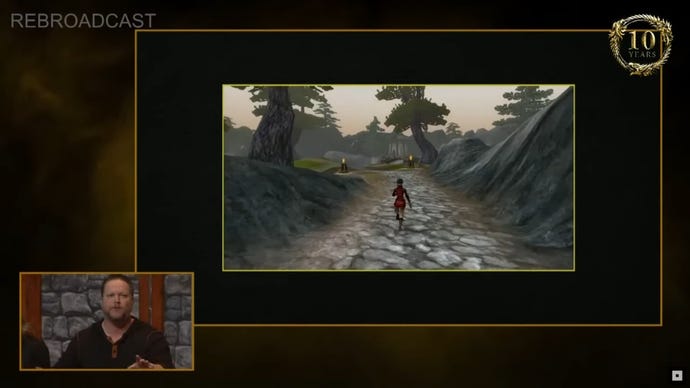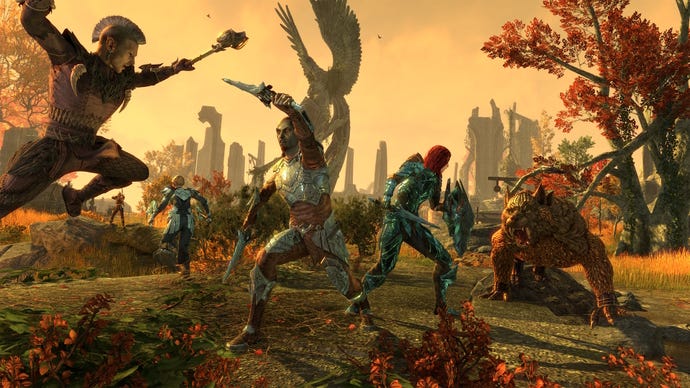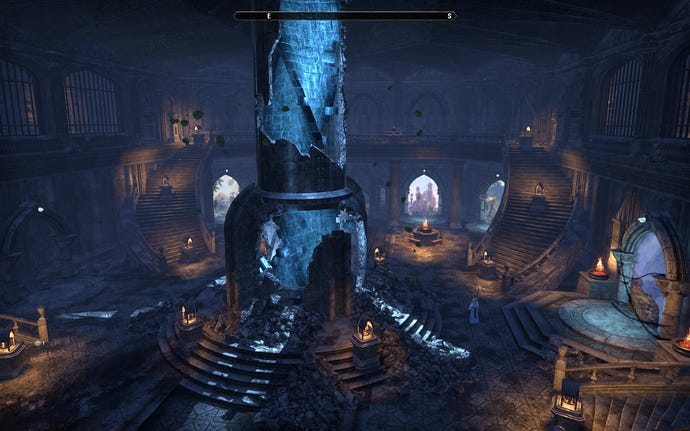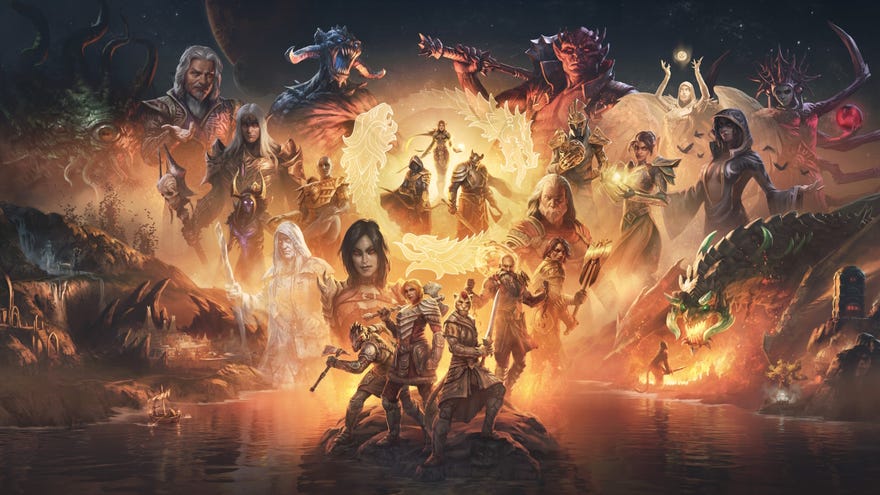World Of Warcraft wasn't the biggest threat to The Elder Scrolls Online; it was Skyrim
Creative director Rich Lambert tells us about ten years in Tamriel
When Bethesda was working out how to turn their popular Elder Scrolls RPGs into an online behemoth to rival World Of Warcraft back in the late 00s, the initial pitch was "Elder Scrolls with friends," creative director Rich Lambert tells me. A simple idea on paper, perhaps, but one that proved to be a lot more complicated in the realisation of it. Zenimax Online Studios was founded in 2007, a year after The Elder Scrolls IV: Oblivion landed to universal critical praise, but it wasn't until seven years later that The Elder Scrolls Online finally released for PC in 2014. At launch "we were walking this weird line between 'online game' and 'Elder Scrolls game'," Lambert says. "We didn't do either of them particularly well."
Ten years later, though, The Elder Scrolls Online is thriving. At last count, the game has over 24 million players galloping about the plains of Tamriel, and later this June, it will receive its eighth major Chapter expansion, Gold Road, which adds Oblivion's West Weald to the game and wraps up the mystery of the new Daedric Prince that arrived at the end of the previous expansion, Necrom. But the path ESO has taken to get here hasn't been nearly as glittering, with its PC launch in particular generating "a lot of feedback", as studio director Matt Firor told press at the game's tenth anniversary event last week. In fact, it wasn't until ESO came to consoles in 2015 that the game really found its voice, says Lambert. "We had to really figure out what we wanted to be, and we chose 'Elder Scrolls'. As soon as we hit that core pillar of 'It's Elder Scrolls first, online second,' then it really just helped inform everything we've done since." Trouble is, when the thrust of ESO's development straddled the launch of two very different Elder Scrolls games, even nailing down that first part of the pillar proved to be more challenging than expected.
When The Elder Scrolls V: Skyrim "got dropped" at the end of 2011, says Lambert, it was make-or-break time for the Zenimax Online Studios team. "Skyrim was like, 'Holy cow! This is very different from what we're building. We've got to change things up.'" It was a huge turning point, because as Lambert describes it, the pre-Skyrim version of ESO hewed much closer to that traditional school of MMO design, following in the footsteps of World Of Warcraft, EverQuest and the work of Mythic Entertainment such as Dark Age Of Camelot, the game where Firor first cut his teeth as an online game designer, as did many of Zenimax Online Studio's other subsequent developers.
For starters, the camera perspective was "more MMO-based," he says, pulled out to give a wider view of the player's surroundings. But when the first and third-person "Skyrim cam" made an appearance, that was one of many features the team felt they had to incorporate and iterate on afterwards. "If [Skyrim] was going to be the game that everybody knew as Elder Scrolls, we had to be more closely resembling that game," Lambert says, recalling how they had to throw out the game's original "great walls of text" and opting instead for a greater focus on voiced conversations. "We didn't originally design ESO to be fully voiced," he explains. "We didn't have the immersive interactions with the NPCs, we didn't have them talking to you. We didn't have all the emotion on the faces and things like that, so we had to solve those problems."
It also included the game's controls. Skyrim had been a monstrous success on home consoles, which meant The Elder Scrolls Online had to also follow suit. And naturally, designing an MMO that played just as nicely on mouse and keyboard as it did on a gamepad affected everything from combat to the game's general interface. "We started thinking more about what does the controller actually mean? It was mouse and keyboard originally, so controllers meant we probably had to do less buttons, and figure out how that worked."

The result was a skill system that let players assign themselves five distinct abilities - on keys 1-5 on PC and a combination of the face and trigger buttons on gamepads - along with a single Ultimate attack. It's quite pared down compared to other MMOs out there, including World Of Warcraft and Final Fantasy 14, but one that arguably puts a greater emphasis on the game's role-playing focus. It's more of a "choose your build before you go into combat" kind of game, says Lambert, "rather than 'I have access to eleven hundred abilities and I can just use them all at once.'"
But even with Skyrim changing the course of ESO's development for the better, its shadow continued loom large over the game's release. Lambert openly admits that ESO "wasn't a particularly strong Elder Scrolls game" when it came out, and that's in part because the studio still hadn't really got their heads round what it meant to play with your friends. "We had a lot of stories early on that separated players by the choices they'd made," Lambert explains. "Looking back on it now, it's like, 'Yeah, we were idiots!'"
He gives an example of a quest where a player has a choice to save a particular town. "In a singleplayer game, that works really great," he says, as you can choose to be the hero and the world will update to reflect that, allowing you to make a meaningful and tangible impact on your surroundings. On in a multiplayer context, however, this type of quest simply doesn't work. After all, what if the friends you're playing with chose not to save that town? The result, it turns out, was that players were getting separated as the game tried to rectify what they should be looking at. "My wife comes to an objective with me and suddenly I disappear and she's left all on her own because she hasn't done the quest and I have - like, that's just not good," Lambert says. "Like, duh, of course!"
This realisation led to Lambert and his team to spend six months after launch effectively "undoing a lot of that stuff" and making significant changes to their various questlines. There are still quests that give players some degree of choice and agency over their decisions, he says, "but now those moments change the skybox colour, or the NPCs change". Smaller, less game-breaking changes that still reflect a player's journey through the world, but which don't prevent them from travelling and playing together as a party.
It was this ethos of always being able to play with others that eventually led to the introduction of the 'One Tamriel' update in 2016, which changed ESO's levelling system and zone structure to be completely non-linear. Players could move through Tamriel's regions freely, and tackle any quest in any order, with the game scaling accordingly behind the scenes. Loot and rewards would still be tailored to your current character level, but there were no restrictions on joining up with players from other factions and alliances. 'Veteran' end-game content such as dungeons and trials remained gated at Level 50, but the rest of ESO's story quests had no such limits attached to them. "That was how we got Elder Scrolls into Elder Scrolls Online," Lambert says.

In the process, it also opened up the game to make it friendlier for first-time players, as there was no longer any need "to grind through" years of older content just to get to the new stuff, Lambert continues. At this point, ESO's player numbers had grown to seven million, a feat no doubt bolstered by the studio's decision to also ditch their initial subscription model for a one-time upfront cost a year earlier. It was a "risky" plan, says Lambert, as no one had ever monetised an MMO like this before. But it was something they'd wanted to do "from the outset," he tells me. "Ultimately it came down to 'how do we get more players into ESO?' And especially when you're on console, you already have to pay for your online access. Having another subscription on top of that? It just felt like it was a lot."
In terms of getting those new players into the real meat of the game, however, Lambert says that even now "we probably need to spend a little bit more time on [that newcomer experience] and put more, or better tutorialisation in there". As a relatively new player myself, this admission surprised me somewhat. Since 2021, ESO has had one main tutorial that teaches you the basics of its combat and exploration. At the end of it, you're let loose in the Keywright's Gallery, a huge portal chamber that lets you jump to the four main areas of the base game, as well as any of its subsequent Chapter expansions right from the off (provided you've bought the latter, of course, otherwise those portal will be roped off with chains draped across the front of them).
But before they created the Keywright's Gallery, Lambert recalls they had six or seven tutorials in total, and they'd "always be focused on getting you into the story of the latest chapter." It wasn't a particularly streamlined approach, and it was also a lot of work for the developers. "We were hoping that it would allow us to not have to make a new tutorial every year," he laughs, but really, the Gallery was mostly created "as a bit of an experiment" to see what would happen if players could simply choose their own adventure.
"It's not been, like, a huge success," Lambert confesses, which again is a shock to me, particularly after hearing about the travails of World Of Warcraft's new player experience last year. Expert players love it, he clarifies. "They go in there, and they're like, 'My character is going to go this way this time.' They just get it and understand it." For newer players, however, it's a lot more intimidating. "When they go in there, especially when they're new, they see eleven portals and they don't know what to do."
Even in the couple of months I've been playing ESO, the Keywright's Gallery has continued to change shape, the arrangement of its portals shifting around as new updates arrive. At time of writing, there are still four portals to choose from at the end of the tutorial, but Lambert says that with Update 41, brand-new players will "only see one portal that takes you to your Alliance starter zone". The hope is that this will reduce the game's friction even further, but Lambert's still very much in a "we'll see how that works" frame of mind about it, suggesting there may yet be even more changes to come further down the line.

The Chapters themselves were also something of an experiment, Lambert tells me, as they weren't originally part of their long-term plan for the game. Rather, they emerged organically as discussions about ESO's future rumbled on. "We were talking about how we could just build enough content, right, and how we were going to do that," he says. "The first probably seven or eight updates that we did were mainly focused around just adding to the game, fixing things and adding new systems." But the team wanted the game to have "a moment", not just for players to hopefully rally round, but to also "break through all the noise in the industry". Eventually they landed on Chapters, which they'd deliver alongside a major update. "It's been super good," says Lambert, and in 2017, they launched the first of what's now become a yearly fixture in the ESO calendar - and it started with the "grandaddy of the Elder Scrolls games", Morrowind.
"[Morrowind] was really what put Elder Scrolls on the map," says Lambert. "I mean, Arena was great, Daggerfall was great, but Morrowind was really the 'Oh my gosh, this is Elder Scrolls, this is cool'. So we wanted to do a tribute to Morrowind and that nostalgia trip."
This year's Chapter, Gold Road, takes players back to Tamriel's West Weald, an area players last saw in Morrowind's mainline successor, The Elder Scrolls IV: Oblivion. It marks a slight shift in how Zenimax Online Studios are approaching their Chapter expansions, as previously each one followed a year-long update pattern. But as Firor said in his 2022 studio director letter, these 12-month storylines have now "run their course", and the intent is to shift over to more "expansive" story arcs that unfold over multiple Chapters. "We're finding more and more that this cadence limits what we can do," he wrote, though how this will affect the game's openness and ease of entry remains to be seen. For Lambert, though, this change is also designed to simply "keep people guessing", as recent player feedback suggested that the yearly updates had "started to feel a little too formulaic".


Surprisingly, he admits that it took "a little bit of convincing" on his part to go ahead with it. "With Necrom, we did this major cliffhanger that we've never done before. I personally don't like doing that. I hate the '[the] movie's good, you're just getting into it, and then it ends, and it's to be continued - and I'm like, awwww." In the end, though, he agrees that "it was the right thing to do", as players "went bonkers" for it.
Indeed, with Gold Road and its conclusion to Necrom's 'Shadow Over Morrowind' story arc due to arrive on June 3rd for PC (with consoles following on June 18th), it seems fitting that The Elder Scrolls Online begins its second decade with another reinvention. This is a game that's had to change and evolve multiple times since its inception, sometimes out of necessity, and others out of pure happenstance. But the results speak for themselves, as this is a game that's transformed from a disappointing Skyrim chaser into arguably one of the biggest MMO juggernauts around. The road ahead seems clear, but as my chat with Lambert draws to a close, I ask him whether, if The Elder Scrolls Online were being made again today from scratch, would it still be an MMO? Or would it more likely fall into the service game bracket like Destiny, Fortnite and many of today's other big hitters?
"It would be an MMO," he says confidently, adding there's still enough differences between the two genres to make them feel unique and distinct. "I have always wanted to make an online game. I met my wife playing EverQuest… like, that's the thing I just - it means so much to me, and so being able to build a game and create a world that people can lose themselves in and meet other people, or meet their significant others, or meet their best friends… I've always wanted to do that, so I would do it again in a heartbeat."


